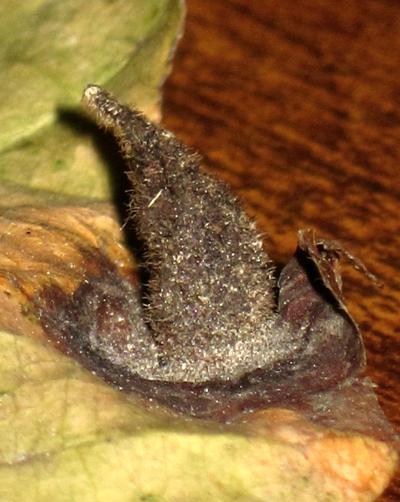©Marlene A. Condon
October 5, 2019

Little dark-brown witches’ hats like this one can be found on the leaves of the native Witch Hazel (Hamamelis virginiana) shrub—just in time for Halloween. Courtesy of Marlene A. Condon
Perhaps nothing is associated more with Halloween than witches who are always pictured as wearing conical black hats. In Virginia this month, you can see what appears to be small (about 3/8-inches tall), blackish witches’ hats on the aging leaves of a common native shrub called (can you believe it?) Witch Hazel (Hamamelis virginiana).
Each “hat” is the result of a miniscule wingless female Witch Hazel Leaf Gall aphid (Hormaphis hamamelidis) that hatched in spring from an egg left upon a branch the previous year. The purplish black, pear-shaped aphid made her way to a leaf bud to feed upon the plant’s sugary juices.
As she fed, she injected chemicals that induced the growing leaf to multiply its cells around her, forming a hollow cone-shaped gall that provided the aphid with a shelter against predators and the weather. Here she fed and produced a new generation of aphids asexually, which means each of her offspring was a clone of its mother.
The witch-hat galls first appear in springtime, colored a bright red that over time turns yellowish green. By fall, the galls are dark brown or black and you can see them by looking closely at the leaves of the Witch Hazel. This plant can often be found growing along rivers and streams, but it is also quite common at higher elevations, such as in Shenandoah National Park and around Mountain Lake, in southwestern Virginia.
Witch Hazel is a garden plant of interest to gardeners because it starts blooming so late in the year, thus adding interest to the landscape after the usual growing season. Come mid-fall, light-yellow strap-like blooms appear, often while the shrub still has its yellowing leaves which tend to hide them. However, once the leaves drop, the blossoms become much more conspicuous.
Some folks might choose to grow Witch Hazel for the medicinal properties of its bark, twigs or leaves. I chose to plant several of these shrubs many years ago specifically to get to see the little witch hats on the leaves. It’s a bit of fantasy brought to life.
Aphids are at the bottom of the food chain, serving as a vital food source for numerous kinds of critters, such as hummingbirds, ladybugs and immature mantids that are so small themselves that they can only catch and eat insects tinier than they are. Witch Hazel Leaf Gall aphids are more vulnerable to predation on their alternate host, the birch tree, where they do not make a gall.
I was thrilled to discover that this shrub easily supports numerous other kinds of insects, such as a very slim caterpillar that pulls a leaf edge over itself that is as neatly folded as a napkin. And just this year, I discovered the Gray Squirrel feeds voraciously upon Witch Hazel seeds.
In the wild, Witch Hazel tends to be an under story plant, growing beneath the canopy of tall trees. But at home, you can grow it in a location that gets full sun to part shade.
Marlene A. Condon is the author/photographer of The Nature-friendly Garden: Creating a Backyard Haven for Plants, Wildlife, and People (Stackpole Books; information at www.marlenecondon.com). You can reach her at marlenecondon@aol.com
